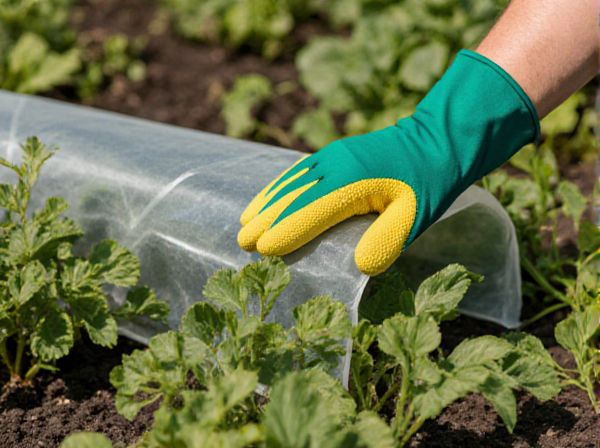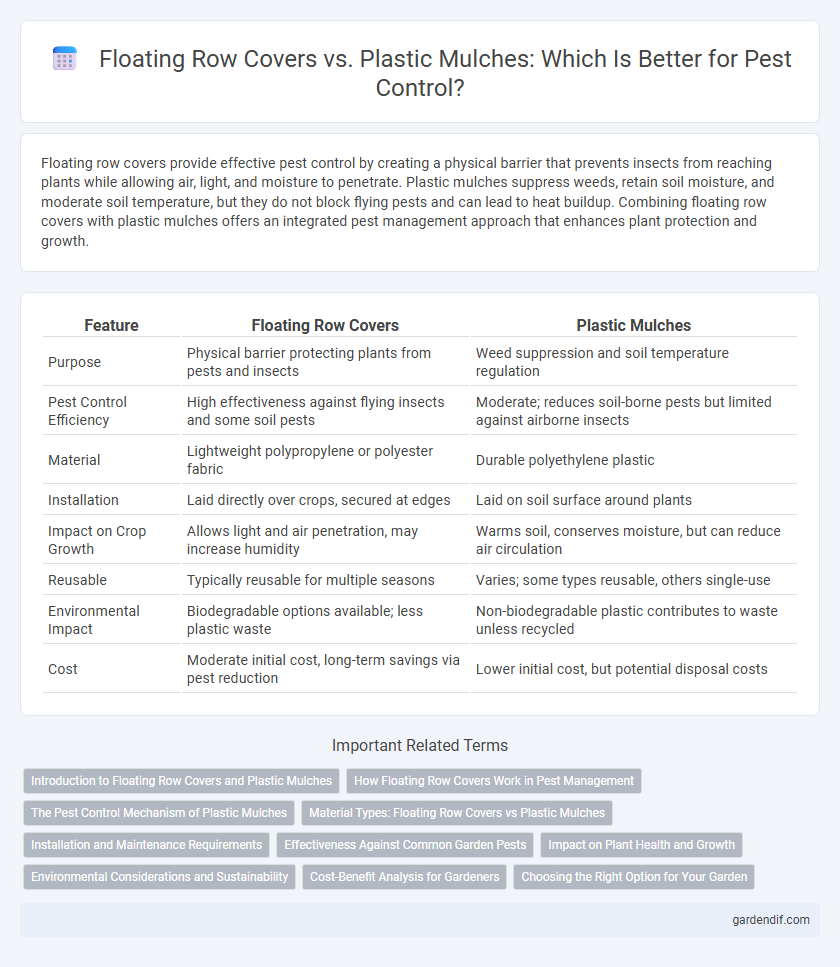
Floating row covers vs Plastic mulches Illustration
Floating row covers provide effective pest control by creating a physical barrier that prevents insects from reaching plants while allowing air, light, and moisture to penetrate. Plastic mulches suppress weeds, retain soil moisture, and moderate soil temperature, but they do not block flying pests and can lead to heat buildup. Combining floating row covers with plastic mulches offers an integrated pest management approach that enhances plant protection and growth.
Table of Comparison
| Feature | Floating Row Covers | Plastic Mulches |
|---|---|---|
| Purpose | Physical barrier protecting plants from pests and insects | Weed suppression and soil temperature regulation |
| Pest Control Efficiency | High effectiveness against flying insects and some soil pests | Moderate; reduces soil-borne pests but limited against airborne insects |
| Material | Lightweight polypropylene or polyester fabric | Durable polyethylene plastic |
| Installation | Laid directly over crops, secured at edges | Laid on soil surface around plants |
| Impact on Crop Growth | Allows light and air penetration, may increase humidity | Warms soil, conserves moisture, but can reduce air circulation |
| Reusable | Typically reusable for multiple seasons | Varies; some types reusable, others single-use |
| Environmental Impact | Biodegradable options available; less plastic waste | Non-biodegradable plastic contributes to waste unless recycled |
| Cost | Moderate initial cost, long-term savings via pest reduction | Lower initial cost, but potential disposal costs |
Introduction to Floating Row Covers and Plastic Mulches
Floating row covers provide a lightweight, breathable barrier that protects crops from pests while allowing sunlight, air, and moisture to penetrate. Plastic mulches, typically made from polyethylene, cover the soil to suppress weeds, retain moisture, and regulate soil temperature, creating a microenvironment conducive to plant growth. Both methods serve as effective pest management strategies by reducing direct contact between plants and harmful insects.
How Floating Row Covers Work in Pest Management
Floating row covers create a physical barrier that prevents pests such as aphids, whiteflies, and beetles from reaching crops, effectively reducing insect infestations without chemical pesticides. These lightweight, breathable fabrics allow sunlight, air, and moisture to penetrate while blocking pest access, promoting healthy plant growth and pest suppression. By interrupting pest life cycles and limiting direct contact with plants, floating row covers enhance integrated pest management strategies and reduce reliance on synthetic chemicals.
The Pest Control Mechanism of Plastic Mulches
Plastic mulches control pests by creating a physical barrier that prevents soil-borne insects from reaching plant roots, inhibiting pest establishment and damage. The reflective surface of some plastic mulches also disrupts insect behavior by repelling aphids, thrips, and whiteflies, reducing infestation rates. Moreover, plastic mulches conserve soil moisture and heat, promoting healthy plant growth that enhances natural pest resistance.
Material Types: Floating Row Covers vs Plastic Mulches
Floating row covers are typically made from lightweight, breathable materials such as spunbonded polyester or polypropylene fabric, which allow air, light, and water to penetrate while providing protection from pests and frost. Plastic mulches generally consist of polyethylene films, available in various colors including black, clear, and reflective, designed to suppress weeds, retain soil moisture, and regulate soil temperature. The porous nature of floating row covers contrasts with the impermeable barrier of plastic mulches, influencing their functionality in pest management and crop growth.
Installation and Maintenance Requirements
Floating row covers require simple installation as they are draped directly over crops and secured with soil or clips, enabling easy removal and minimal labor. Plastic mulches demand more effort for installation, involving laying and securing sheets tightly over the soil, often requiring specialized equipment. Maintenance for floating row covers mainly involves periodic adjustments and repairs to avoid damage from wind or pests, whereas plastic mulches require monitoring for tears, proper edge sealing, and eventual removal or replacement to prevent soil degradation.
Effectiveness Against Common Garden Pests
Floating row covers create a physical barrier that effectively protects plants from common pests such as aphids, flea beetles, and cabbage worms by preventing direct contact. Plastic mulches suppress weeds and reduce soil-borne pests like cutworms and root maggots by altering soil temperature and moisture but offer limited defense against foliar insects. Combining floating row covers with plastic mulches can enhance pest management by targeting both above-ground and below-ground pest threats in vegetable gardens.
Impact on Plant Health and Growth
Floating row covers improve plant health by providing a breathable barrier that protects crops from pests and extreme weather, allowing for improved air circulation and reducing fungal diseases. Plastic mulches enhance soil temperature and moisture retention, promoting faster growth and higher yields, but may increase the risk of overheating and reduced oxygen to roots. Both methods contribute to pest management, but floating row covers offer a more balanced environment for healthy plant development and long-term growth sustainability.
Environmental Considerations and Sustainability
Floating row covers offer a reusable and biodegradable option that reduces plastic waste, promoting sustainable pest management practices. Plastic mulches, while effective in weed control and moisture retention, often contribute to long-term environmental pollution due to their non-biodegradable nature and disposal challenges. Integrating floating row covers can enhance eco-friendly agriculture by minimizing plastic use and supporting soil health.
Cost-Benefit Analysis for Gardeners
Floating row covers offer a cost-effective solution for gardeners by providing pest protection and microclimate enhancement with reusable, lightweight fabric that requires minimal maintenance. Plastic mulches tend to have higher initial costs and disposal concerns but improve soil moisture retention and temperature regulation, potentially boosting crop yields. Gardeners should weigh the long-term savings and environmental impact of floating row covers against the crop-specific benefits and costs associated with plastic mulches for optimal pest management.
Choosing the Right Option for Your Garden
Floating row covers provide a breathable barrier that protects plants from pests and extreme weather without suffocating growth, making them ideal for managing insects like aphids and beetles. Plastic mulches suppress weeds, retain soil moisture, and warm the soil, benefiting crops such as tomatoes and peppers, but they do not prevent insect access and can increase pest pressure beneath the mulch. Selecting the right option depends on your garden's specific pests, climate conditions, and crop types to optimize plant health and yield.
Floating row covers vs Plastic mulches Infographic

 gardendif.com
gardendif.com